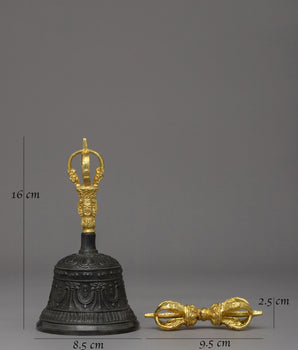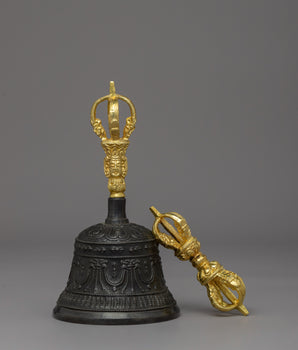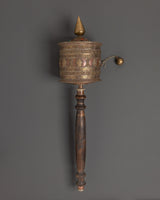
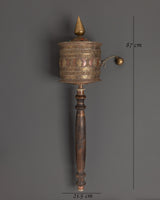
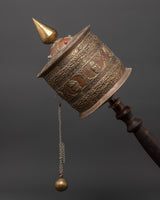
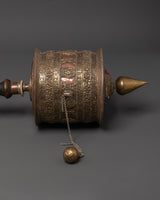
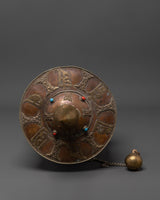
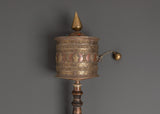
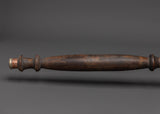
Handcrafted Himalayan Prayer Wheel | Copper & Brass Mantra Wheel with Wood Handle

100% AUTHENTIC

HANDMADE

FREE SHIPPING
Handcrafted Himalayan Prayer Wheel | Buddhist Ritual Wheel for Altar Decor
--------------------------------------------------------
Size: 87cm(Height) x 21.5cm (Width)
Weight: 2.20kg
Materials: Brass, Copper, Wood
--------------------------------------------------------
About our Prayer Wheel
This wonderful Himalayan prayer wheel is 87 cm tall, 21.5 cm broad, and weighs 2.20 kg. Its drum is expertly spun from brass and copper, featuring the mantra "Om Mani Padme Hum" and auspicious symbols in excellent relief. Mounted on a hand-turned wooden handle, the wheel's brass cap and finial have polished details that catch the light, and the rod gives a comfortable grip for smooth, rhythmical spinning.
Each prayer wheel is created by expert Himalayan artisans who utilize centuries-old metalworking skills. The imprinted mantras and decorated bands of lotus petals, vajras, and endless knots are made using careful repoussé and chasing. Inside, a carefully wound scroll of mantra-inscribed paper ensures that blessings are released with each turn. The wood handle is coated in a rich patina to match the metalwork and allow for easy rotation during use.
This prayer wheel is ideal for Buddhist altars, meditation areas, yoga studios, or holy places. It infuses surroundings with compassion and mindfulness. Spin it to boost your mantra practice, bless your home, or say prayers for peace and well-being.
Introduction to Prayer Wheel
A prayer wheel is cylindrical on a spindle. It is used in Tibetan Buddhism It is typically inscribed with the mantra "Om Mani Padme Hum" and rotated by hand as a form of spiritual practice and to accumulate merit Spinning the wheel is believed to have the same spiritual benefits as verbally reciting the mantra The use of prayer wheels is widespread in Tibetan Buddhism and has spread to other cultures.
How does the Buddhist Prayer Wheel benefit us?
The benefits associated with rotating the wheel are numerous It promotes knowledge, compassion, and bodhicitta in the practitioner and improves siddhis (spiritual powers such as clairvoyance, precognition, etc.) The practitioner can repeat the mantra as often as possible while the wheel is rolling, maintaining a calm, meditative attitude A Tibetan Buddhist tradition holds that after a practice session, one should dedicate any acquired merits to the benefit of all sentient beings Then three times Om Ah Hum This is usually among Tibetans after finishing any Buddhist practice, including the prayer wheel exercise.
How do you set up your own Buddhist Shrine?
• Find a clean, quiet, and uncluttered spot
• Set up an altar table and cover it with an altar cloth that calls to you
• Place your sacred item at the center
















